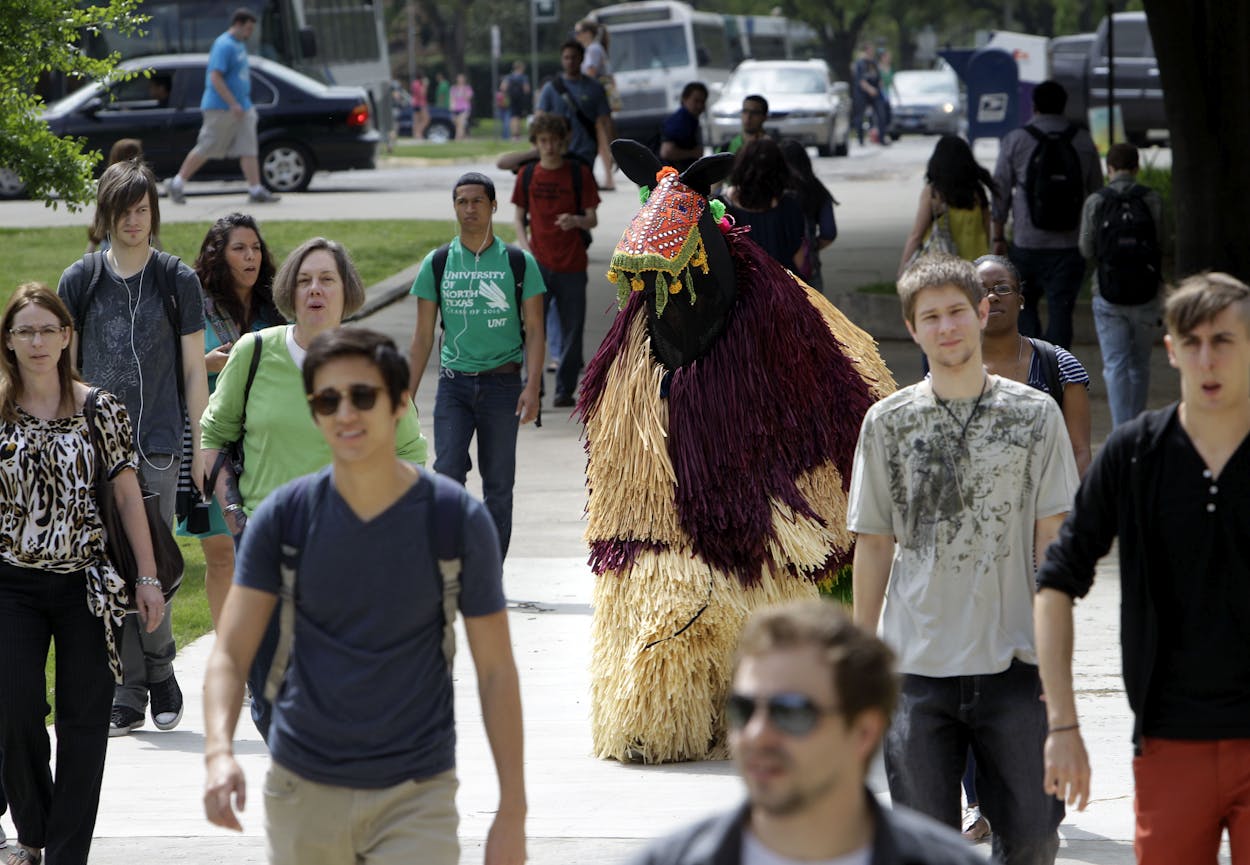In the five years since the University of North Texas’s Apogee Stadium opened, the $78 million home base for the Mean Green has seemed like a complete waste. UNT’s football team is about as functional as putting an orange in a keyhole to open a door. But even if UNT isn’t breaking records on the football field (last season the team won exactly one game), it is setting the curve for sustainability. Apogee Stadium is “the first newly constructed collegiate football stadium in the nation to achieve the highest level of LEED certification,” or LEED Platinum. Leading the way in sustainability, environmental research, and energy consumption is a wonderful achievement for any university. And it looks like using football as a conduit to accomplish tangible milestones (which, apparently, doesn’t include a winning team) seems to be a trend that suits UNT nicely.
UNT is in the beginning stages of entering an exclusive agreement with the Dallas Cowboys, which certainly raises some eyebrows considering the game of football is bleak in Denton. Nevertheless, the collaboration looks like it could be particularly valuable for the school’s academics.
Last Thursday and Friday, UNT’s Board of Regents discussed and voted on whether or not the University of North Texas System Chancellor Lee Jackson and President Neal Smatresk would be allowed to draw up a deal with the Cowboys without the board’s oversight. Unanimously, the board voted yes. The deal is in its infancy and certainly subject to change, but the potential terms see UNT paying the Cowboys $1 million or more in order to become a “Proud Partner of the Dallas Cowboys.” According to a meeting memo, this would allow UNT to use the “team’s star and other primary logos; a blend of digital in-stadium, in restaurant and concourse advertising at The Ford Center and AT&T Stadium; digital mixed-use exterior banner and highway marquee advertising; select event exhibit space; game-day radio spots; preseason network and Jason Garrett show televised commercials; and a microsite and ads on the DallasCowboys.com web site.”
So UNT would be an academic institution that is also a major advertising partner with a franchise colloquially referred to as “America’s Team.” The Cowboys had an abysmal 2015 season, but are still tied sixth for the most prime-time televised games for the 2016 season. Brint Ryan, chairman of the university’s board of regents, told the Denton Record-Chronicle that this is “going to be a significant boost to [UNT’s] new campus in Frisco,” and that he thinks it will help elevate the school’s overall brand. With the level of visibility outlined in the memo, it surely will. It will also provide crucial academic incentives that are advantageous for students.
The partnership is expected to include “integrated academic and student internship programs” at the Cowboys’ new headquarters and training facility in Frisco, The Ford Center at the Star. Students will be able to participate in an extensive advertising program at the Ford Center and at AT&T Stadium in Arlington. Outside of advertising, the memo states that the alliance is expected to provide opportunities for students pursuing careers in broadcast journalism, hospitality management, sports media and event management, and recreation events and sports management. Marketing, data analytics, digital retailing, and information technology are also involved in the talks. These incentives are unique, something not provided by many, if any, of the top colleges in the nation. An exclusive partnership like this helps UNT in the mad dash of Texas public university one-upmanship.
Earlier this year, UNT, along with Texas Tech University, the University of Texas at Arlington, and the University of Texas at Dallas, were designated by the Carnegie Classification of Institutions of Higher Education as tier one schools. There are only eight institutions in Texas (University of Texas at Austin, Texas A&M University, Rice University, and the University of Houston) and 115 throughout the country with this classification, which is given to schools with the highest research activity, funding dedicated to research, selective admissions, and amount of doctoral degrees it awards. The distinction for public colleges is prestigious, and one that lawmakers and university brass have been salivating over for years. However, the justifiably criticized but incredibly popular U.S. News & World Report does not recognize UNT as a tier one school within its rankings, nor are they a part of an even more exclusive club of 62 universities in North America called the Association of American Universities. Three Texas colleges are, though: UT, A&M, and Rice.
Until this year, the Dallas metro area didn’t have a single college considered tier one by Carnegie, and now it has three. Out of the tier one schools in the area, the University of Texas at Dallas, in Richardson, has made wonderful strides. But undergraduate enrollment numbers are at just 14,300, ranking eleventh among all Texas schools right in front of the private Baylor University, which has 13,859 undergraduate students. UNT on the other hand, has over 30,000 undergraduates, and UTA has over 26,000. Suffice to say, when it comes to becoming a major competitive public school in the third largest metro region in America, the throne is for the taking.
Along with amenities like state-of-the-art recreation centers and swanky dorms, opportunities and prestige are among the sexiest attributes of a school when if comes to attracting prospective students. When UNT received tier one status, Smatresk noted that it was an important milestone, but there’s still work to do in order to increase the school’s national reputation. And an advertisement and academic partnering with the Cowboys is a major step in that direction. It’s definitely bizarre, but an exclusive opportunity to work within a powerhouse sports organization is a rare and valuable opportunity.






